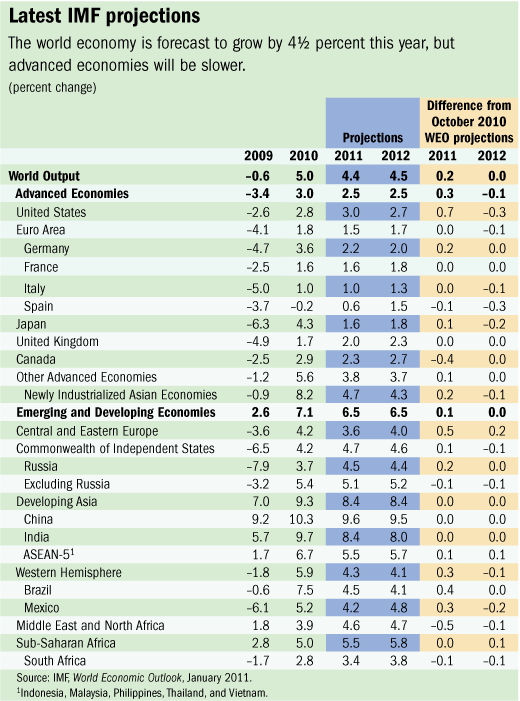
Typical street scene in Santa Ana, El Salvador. (Photo: iStock)
IMF Survey: World Still Needs to Fix Key Economic, Financial Problems
January 25, 2011
- Global output forecast to expand by about 4½ percent in 2011, slight upward revision
- Advanced economies' growth to slow to 2.5 percent from 3.0 percent last year
- Emerging markets to see average 6.5 percent growth, down from 7.1 percent in 2010
- Global financial stability still at risk, needs urgent and comprehensive response
Although the world is on a recovery path from the global economic crisis, action is still needed to address key constraints in the international economy and financial system, including high unemployment and banking problems in advanced economies and risks of overheating in emerging markets, according to the International Monetary Fund (IMF).

Market in Sao Paulo, Brazil: rapid growth in emerging, developing economies has narrowed or closed output gaps in these economies (photo: Luis Cleber/Newscom)
GLOBAL UPDATE
The IMF released updates to its two flagship analyses, the World Economic Outlook (WEO) and the Global Financial Stability Report (GFSR), showing that the world is in a two-speed economic recovery, with advanced economies still recovering slowly and emerging markets and even some low-income countries relatively buoyant. The IMF will release an update to its Fiscal Monitor in Washington on January 27.
“Nearly four years after the onset of the largest financial crisis since the Great Depression, global financial stability is still not assured and there remain significant policy challenges to be addressed,” the GFSR, released in Johannesburg on January 25, said.
Global output is projected to expand by about 4½ percent in 2011 (see table), an upward revision of about a ¼ percentage point relative to the October 2010 WEO. IMF economists said this reflects stronger-than-expected activity in the second half of 2010 as well as new policy initiatives in the United States that will boost activity this year.

Overall, advanced economies are projected to grow by 2.5 percent in 2011, with emerging and developing economies seeing growth of 6.5 percent, against 7.1 percent last year. Growth in sub-Saharan Africa will climb to 5.5 percent, from 5.0 percent in 2010.
Need for rapid action
“The most urgent requirements for robust recovery are comprehensive and rapid actions to overcome sovereign and financial troubles in the euro area and policies to redress fiscal imbalances and to repair and reform financial systems in advanced economies more generally. These need to be complemented with policies that keep overheating pressures in check and facilitate external rebalancing in key emerging economies,” the WEO Update said.
Olivier Blanchard, the IMF’s Chief Economist, identified two key issues for the global economy at this point.
“First, how emerging market countries handle capital inflows. High growth in emerging market countries, together with low interest rates in advanced countries, has triggered strong capital flows to both Latin America and Asia,” said Blanchard, speaking ahead of the joint release at the Sandton Convention Center in Johannesburg, South Africa.
“These capital flows present both an opportunity and a challenge for emerging economies. An opportunity, as they decrease the cost at which these countries can borrow; a challenge because they can lead to overheating and bubbles.”
The second issue is that continued slow growth in advanced countries will mean that unemployment rates stay high and the environment for fiscal consolidation—policies aimed at reducing government deficits and debt accumulation—remains difficult. “Low growth makes it difficult to consolidate too fast, but consolidation has to start now to control large lingering deficits.”
Pressure for comprehensive solution
José Viñals, Financial Counsellor and Director of the IMF’s Monetary and Capital Markets Department, told reporters that the slow growth prospects of advanced economies and the continued weakness in their fiscal balances have raised the market’s sensitivity to debt sustainability risks.
“While still contained to the euro area, the adverse interaction between the sovereign and banking risks in a number of countries has intensified, leading to disruptions in some funding markets,” he said.
The current detrimental interaction between financial system stability and sovereign debt sustainability needs to be dealt with in a comprehensive fashion, so as to break the adverse feedback loop that could spread beyond the smaller euro-area countries, the GFSR Update said. “Pressing forward with the regulatory reform agenda—for both institutions and markets—continues to be crucial. Without further progress in this field, sustainable growth and global financial stability will remain elusive.”
Commodity price rises to persist
Upward pressure on commodity prices is expected to persist in 2011, due to continued robust demand and a sluggish supply response to tightening market conditions. As a result, the IMF’s baseline petroleum price projection for 2011 is now $90 per barrel, up from $79 per barrel in the October 2010 WEO.
As for non-oil commodities, weather-related crop damage was greater than expected in late 2010, and prices are likely to fall back only after the 2011 crop season. As a result, non-oil commodity prices are expected to increase by 11 percent in 2011.
Although inflation is generally under control in advanced economies, the recent bout of high food price inflation in some emerging markets has been quite persistent, straining the budgets of low-income households and beginning to feed into overall price inflation in a number of economies.
More important, rapid growth in emerging and developing economies has narrowed or in some cases closed output gaps in these economies. Accordingly, risks of overheating have increased. Consumer prices in these economies are projected to rise 6 percent this year, an upward revision of ¾ percent relative to the October 2010 WEO.


